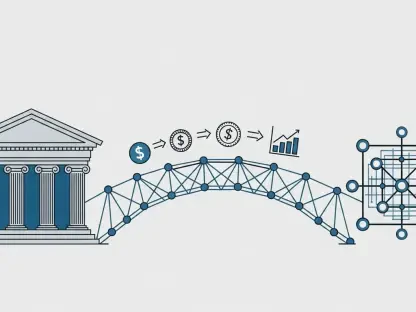In an era where digital transformation is reshaping the foundations of global finance, the emergence of cryptocurrencies as potential reserve assets has sparked intense debate among industry leaders and institutional investors. One asset, XRP, stands out due to its unique design and growing interest from financial entities looking for alternatives to traditional reserves like gold. With its promise of speed, scalability, and efficiency, XRP is being positioned by some experts as a tool that could bridge the gap between conventional financial systems and the rapidly evolving digital landscape. This discussion delves into whether XRP has the capacity to redefine what a reserve asset means in the modern context, moving beyond speculative hype to focus on practical utility. By examining its technological advantages and institutional appeal, a clearer picture emerges of how this digital asset might carve out a significant role in the future of finance, challenging long-held norms and offering innovative solutions to persistent problems.
XRP as a Modern Alternative to Traditional Reserves
The comparison of XRP to gold as a reserve asset reveals both striking parallels and critical differences that highlight its potential in digital finance. Like gold, XRP is viewed by some as a store of value, but its digital nature eliminates the physical constraints that make gold cumbersome for transactions. Gold cannot be easily divided or transported across borders without significant cost and logistical hurdles, whereas XRP enables near-instantaneous transfers at a fraction of the expense. This efficiency is particularly appealing to institutions managing large-scale cross-border payments, where speed and cost-effectiveness are paramount. Furthermore, XRP’s divisibility allows for precise allocations, a feature traditional reserves often lack. As financial systems increasingly demand liquidity and portability, XRP’s ability to meet these needs positions it as a compelling alternative that could complement or even rival established assets in specific use cases, reshaping how reserves are perceived and utilized.
Another key aspect of XRP’s potential lies in its scalability and interoperability, which address modern financial demands far beyond what physical assets can achieve. Designed to handle high transaction volumes, XRP can process thousands of transactions per second, a stark contrast to the delays inherent in traditional banking systems or the handling of physical reserves. Its ability to integrate seamlessly across diverse financial networks further enhances its appeal as a settlement tool for institutions navigating complex global markets. This technological edge is not merely a convenience but a fundamental shift in how value can be transferred and stored without the friction of outdated infrastructures. As digital transactions become the norm, the structural advantages of XRP suggest it could play a pivotal role in redefining reserve assets, offering a solution that aligns with the pace and scale of today’s economy while providing a regulatory-friendly framework that many institutions are beginning to trust.
Institutional Adoption and Practical Utility
A growing trend among financial institutions is the quiet accumulation of XRP, driven by its perceived utility rather than market speculation. Industry voices argue that this digital asset is gaining traction as a reliable tool for managing cross-border transactions and maintaining liquidity in volatile environments. Unlike many cryptocurrencies fueled by retail investor hype, XRP’s appeal to banks and payment providers stems from its ability to reduce settlement times from days to mere seconds, slashing operational costs in the process. This practical application is a significant departure from viewing digital assets as mere speculative instruments, signaling a broader shift toward integrating them into mainstream financial operations. The confidence in XRP’s long-term value is evident in the strategic moves by some institutions to position it as a complementary reserve, capable of bridging traditional and digital financial ecosystems with minimal disruption.
Beyond transactional efficiency, XRP’s alignment with institutional needs underscores its potential to redefine reserve functions over the coming years. Its design prioritizes regulatory compatibility, an essential factor for entities operating under strict compliance frameworks. This makes XRP a less risky proposition compared to other digital assets that face uncertain legal landscapes. Additionally, the asset’s capacity to serve as a neutral intermediary in currency exchanges eliminates the need for multiple intermediaries, streamlining processes that have long plagued international finance. As more institutions recognize these benefits, the gradual adoption of XRP could pave the way for a new standard in reserve management, where digital solutions are not just optional but integral. The focus on utility over short-term gains reflects a mature approach to integrating technology into finance, prioritizing sustainable impact over fleeting trends in a rapidly digitizing world.
Reflecting on a Path Forward for Digital Reserves
Looking back, the journey of XRP reveals a nuanced optimism among experts who champion its technological strengths and institutional relevance over speculative fervor. The emphasis on speed, scalability, and interoperability underscores a pivotal moment where digital assets began transitioning from niche experiments to practical tools in global finance. What stands out is the patience exhibited by early adopters, who understood that widespread acceptance would take time despite the evident advantages. Their belief in XRP as a transformative force in reserve management highlights a critical shift in thinking, where utility drives value. Moving forward, stakeholders must focus on fostering regulatory clarity and building robust infrastructures to support broader integration. Encouraging collaboration between traditional financial bodies and digital innovators will be essential to unlocking XRP’s full potential, ensuring it can evolve into a cornerstone of modern reserve systems while addressing emerging challenges in an interconnected financial landscape.









